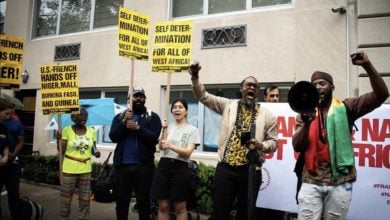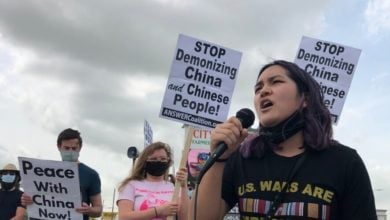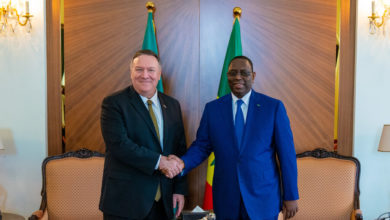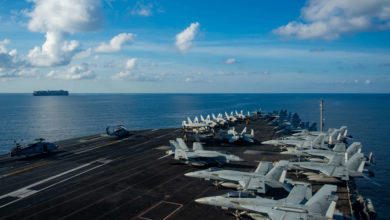On Oct. 24, U.S. Secretary of State John Kerry met with Russian Foreign Minister Sergey Lavrov in Vienna to discuss finding a solution to the crisis in Syria. The day before, the two had another meeting, along with the prime ministers of Saudi Arabia and Turkey.
The Syrian civil war has entered a new stage. On Sept. 30, Russia started intervening directly in the Syrian crisis. The Russian military is conducting a bombing campaign in direct coordination with the Syrian military. With Russian air support, the Syrian army is moving in the direction of Aleppo, Syria’s second largest city, which has been under the control of the opposition rebels for some time.
Also, for the first time, there are credible reports of Iranian military forces directly involved in the fighting. Whereas previously, the Syrian state received support from Russia and Iran mainly in the form of financial assistance and military training and advice, now Russia and Iran are directly involved in the fighting. Of course, Hezbollah, the resistance organization that fought off the Israeli assault on Lebanon in 2006, has long been engaged in the fight in Syria.
It is too early to determine whether Russian military intervention will be a deciding factor in the Syrian civil war. But the early indications are that Russia’s intervention has had a major impact. The U.S. and its junior imperialist allies have been bombing targets in Syria and Iraq for some time now. But the effect of the U.S. bombing campaign has been quite limited, mainly because, with a few exceptions such as the case of Kobani, U.S. bombings have not been coordinated with forces on the ground. The main force on the ground fighting the Islamic State, the Nusra Front and other mainly Islamist rebel forces, has been the Syrian military. And, of course, U.S. strategy is to overthrow the Syrian state, hence no coordination with the military.
Over four years into the civil war, the living conditions of the people of Syria can only be described as catastrophic. Most of the heavily populated parts of the country are still controlled by the state, while expansive parts are under the Islamic State, yet others controlled by a patchwork of rebel groups, many of which are now unified under the leadership of the Nusra Front, the Syrian affiliate of Al Qaeda. The number of people killed easily runs into the hundreds of thousands. And, in a country torn by such a bloody civil war, the country’s economic life has ceased to function normally, forcing people to live in deplorable conditions. Further, millions are displaced, either internally within Syria, or forced to seek refuge in other parts of the world. The refugee crisis in Europe is, in large part, fueled by hundreds of thousands of Syrian refugees.
U.S. intervention the main contributor to civil war
Syria’s descent into the civil war started in the spring of 2011, when large-scale demonstrations against the state broke out. The demonstrations were far from unified in their demands, ranging from people who demanded more democratic governance to those who had for decades wanted to overthrow the state and replace it with a sectarian Sunni Islamic state. By and large, the Syrian state had followed an independent course, providing support to Palestinian resistance and being a thorn on the side of the settler state of Israel.
Without U.S. intervention, it would not have been a foregone conclusion that demonstrations would lead to an all-out civil war. Despite the fact that President Bashar Assad’s state reacted to many of the demonstrations with repression, it also declared its willingness to implement reforms and to negotiate with unarmed opposition forces.
This was not an idle promise. Over the next few months, Damascus significantly opened up the political realm for anyone not engaged in an armed struggle against the state. In addition to holding presidential elections, in which President Bashar Assad was re-elected, a much more open election was held for parliament on May 7, 2012. In these elections, a coalition of different political forces called the National Progressive Front (al-jabha al-waTaniyyah at-taqaddumiyyah) won more seats than the long-ruling Baath party, of which Assad is a member.
But the demonstrations in Syria were taking place as the U.S. and its NATO allies were bombing Libya. Regime change in Libya was being implemented through the relentless bombing of the country. The overthrow of the independent state of Libya, under the leadership of Moammar Qaddafi, was unfolding as the opposition in Syria was taking shape.
Just as Qaddafi had been demonized by the imperialist propaganda machine, Assad was being demonized as a bloodthirsty leader bent on killing his people, all of whom were supposedly united against him. It was not hard to imagine Syria experiencing a similar fate as that of Libya. In fact, that was the common expectation. Most expected Damascus to fall as a result of U.S. intervention, either in the form of direct bombing, as was the case in Libya, or funding, arming, training and organizing opposition forces.
Under such circumstances, there was little possibility of a Syrian opposition committed to a political struggle for an independent Syria to gain strength. Instead, forces committed to armed struggle to overthrow of the state gained power. All the major opposition forces assumed that it was only a matter of time before the state would be overthrown. The only question now was the nature of the state replacing it.
The U.S. declared that “Assad must go.” It started funding various armed groups fighting for the overthrow of the state. Through arch reactionary Gulf monarchies Saudi Arabia and Qatar, arms and funding flooded to the opposition rebels. Syria’s U.S. client state neighbors, Turkey and Jordan, turned their border areas into training grounds for armed opposition forces.
But the Libyan model of the overthrow of an independent state was not to be repeated in Syria. Unlike the case of Libya, Russia and China refused to sign on to a similar “No Fly Zone” U.N. resolution. A NATO bombing of Syria never happened.
As we look at where Syria is today, it is important to emphasize that U.S. policy is one of the main reasons why Syria has descended into the state that it is in today.
Pro-democracy opposition?
Liberals in the U.S., along with many self-proclaimed socialists, championed the cause of the Syrian “democratic opposition,” even though there was little evidence of actual democratic opposition forces existing on the ground. The dominant ideology of the various rebel groups in Syria is that of reactionary sectarian Islamists, the two main poles being the Islamic State and the Nusra Front.
It is instructive that, in lockstep with the U.S. government, these liberal forces have consistently rejected out of hand, even ridiculed, any suggestion of a possible future for Syria without Assad being overthrown first. These same forces never take such an inflexible position on other states in the region that are far more repressive than Syria. We do not see calls for the unconditional overthrow of the monarchy in Jordan, Syria’s neighbor and a main contributor to Syria’s “pro-democracy” rebels. Nor do we see calls for the unconditional overthrow of the main funders of Syria’s “pro-democracy” forces, Saudi Arabia and Qatar. Bahrain, ruthlessly oppressed by the Khalifa family dynasty, is not singled out for overthrow, despite the fact that large anti-government demonstrations were violently repressed, with the military help of no less than the Saudi monarchy.
To this day, years into a bloody civil war involving many sides, U.S. officials and media outlets repeat the propaganda line: “Assad is killing his own people.” By definition, in any civil war, all warring parties “kill their own people.” The Free Syrian Army kill their own people, as do ISIS, Nusra and other rebel forces. But the “killing his own people” designation is a charge reserved for Assad, as far as imperialist mouthpieces are concerned.
Under the current balance of forces in Syria, it is obvious that the only real alternative to ISIS and Al Qaeda is the Syrian state in Damascus. But the demonization of the Assad leadership has taken such deep roots that stating this obvious fact is ridiculed by U.S. officials and liberal political forces in the West alike.
Failed U.S. policy
By every conceivable measure, U.S. policy in Syria has been an abysmal failure. By promoting Assad’s overthrow, the U.S. hoped that it would create a pro-imperialist Syrian political force abroad to take over the state. This led to the formation of the Syrian National Council, the brain child of then Secretary of State Hillary Clinton. But the Syrian National Council, which later morphed into the Syrian National Coalition, failed to become a political formation around which the opposition would coalesce. More damaging to U.S. aims, the Free Syrian Army, the directly U.S. supported fighting force on the ground, steadily lost ground to Nusra and other Islamist rebel groups. Eventually, in June 2014, with ISIS occupying one-third of Syrian territory, the FSA effectively turned into a fringe force, far out-powered by other rebel forces.
In the late summer of 2013, the Obama administration made serious preparations for bombing Syria. The pretext was a poison gas attack for which responsibility was not established and the Syrian state had the least motive to perpetrate. But Russia’s intervention and the agreement of the Syrian state to dismantle its chemical weapons deprived the Obama administration of its pretext to start a new war.
Over the last year, seeing the need for bolstering pro-imperialist forces on the ground, the U.S. launched a $500 million program to train and organize 5,000 Syrian fighters. This program did not just fail; it failed comically. In a September report to a Senate committee on the program, the head of Centcom, General Lloyd J Austin III, testified that “only four or five” Syrians trained by the U.S. military remained in the fight. This unbelievable report by General Austin prompted Senator Claire McCaskill to say: “So we’re counting on our fingers and toes at this point, when we had envisioned 5,400 by the end of the year.” As it turns out, only the fingers on one hand were sufficient to help with the count.
Other than the “four or five,” the rest of the U.S.-trained forces have not just disappeared. Many of them, along with their weapons and other military hardware, have joined other rebel groups that even the U.S. considers to be terrorists. According to the L.A. times, “on Sept. 23, a U.S.-backed commander, along with 70 fighters, joined Al Nusra Front after receiving training and a cache of weapons in neighboring Turkey.”
Washington also has the challenge of its different clients intervening in Syria with conflicting interests. Saudi Arabia and Qatar have shown no reservations in supporting Al Qaeda-allied forces, something that the U.S. is opposed to. Turkey is warning the U.S. against any cooperation and coordination with the YPG and other Kurdish forces. Turkey fears that potential Kurdish victories in Syria could contribute to the Kurdish resistance movement in Turkey, where the largest Kurdish minority lives under extreme repression from Ankara. Against all odds, the U.S. continues to hold on to the hope that the FSA will eventually turn into a major player. That is why the U.S. is loudly complaining against Russian bombings, which the U.S. believes should only be directed against ISIS, not the pro-West rebels.
There are no easy solutions to the current conflict in Syria. The task of the U.S. anti-war movement is to continue what its anti-imperialist wing has done all along—condemn and oppose U.S. intervention in all its shapes and forms. U.S. intervention is the major cause of the nightmare that Syria is living through today. The main source of the problem will never be the solution.





